

Compact Muon Solenoid
LHC, CERN
| CMS-FSQ-15-009 ; CERN-EP-2019-151 | ||
| Bose-Einstein correlations of charged hadrons in proton-proton collisions at $\sqrt{s} = $ 13 TeV | ||
| CMS Collaboration | ||
| 20 October 2019 | ||
| JHEP 03 (2020) 014 | ||
| Abstract: Bose-Einstein correlations of charged hadrons are measured over a broad multiplicity range, from a few particles up to about 250 reconstructed charged hadrons in proton-proton collisions at $\sqrt{s} = $ 13 TeV. The results are based on data collected using the CMS detector at the LHC during runs with a special low-pileup configuration. Three analysis techniques with different degrees of dependence on simulations are used to remove the non-Bose-Einstein background from the correlation functions. All three methods give consistent results. The measured lengths of homogeneity are studied as functions of particle multiplicity as well as average pair transverse momentum and mass. The results are compared with data from both CMS and ATLAS at $\sqrt{s} = $ 7 TeV, as well as with theoretical predictions. | ||
| Links: e-print arXiv:1910.08815 [hep-ex] (PDF) ; CDS record ; inSPIRE record ; HepData record ; CADI line (restricted) ; | ||
| Figures & Tables | Summary | Additional Figures | References | CMS Publications |
|---|
| Figures | |
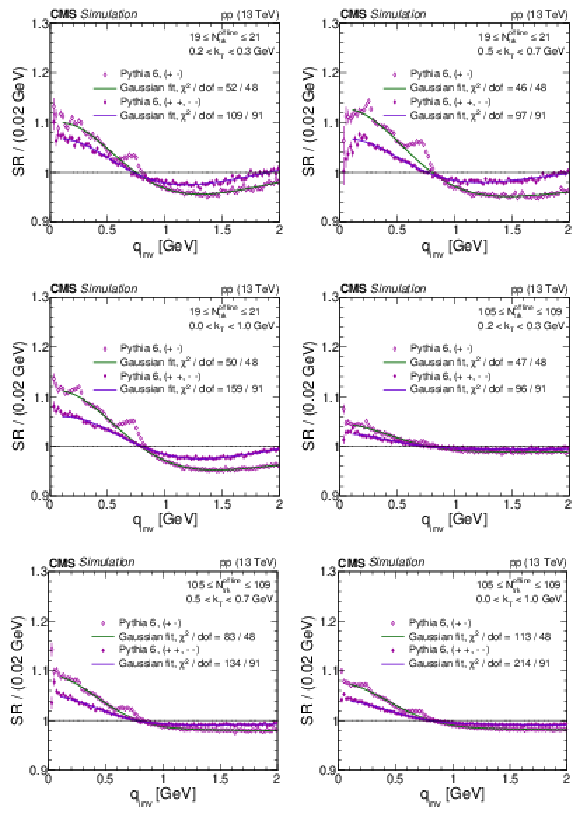
png pdf |
Figure 1:
The same-sign ($++,-$) and opposite-sign ($+-$) single ratios employing PYTHIA 6 (Z2* tune) in different bins of $N^\text {offline}_\text {trk}$ and $ {k_{\mathrm {T}}} $ with the respective Gaussian fit from Eq. (4). The following $ {q_\text {inv}} $ ranges are excluded from the fits: 0.2 $ < {q_\text {inv}} < $ 0.3, 0.4 $ < {q_\text {inv}} < $ 0.9, and 0.95 $ < {q_\text {inv}} < $ 1.2 GeV. Coulomb interactions are not included in the simulation. The error bars represent statistical uncertainties and in most cases are smaller than the marker size. |

png pdf |
Figure 1-a:
The same-sign ($++,-$) and opposite-sign ($+-$) single ratios employing PYTHIA 6 (Z2* tune) in bin 19 $ \leq N^\text {offline}_\text {trk} \leq $ 21 and 0.2 $ < {k_{\mathrm {T}}} \leq $ 0.3 GeV with the Gaussian fit from Eq. (4). The following $ {q_\text {inv}} $ ranges are excluded from the fits: 0.2 $ < {q_\text {inv}} < $ 0.3, 0.4 $ < {q_\text {inv}} < $ 0.9, and 0.95 $ < {q_\text {inv}} < $ 1.2 GeV. Coulomb interactions are not included in the simulation. The error bars represent statistical uncertainties and in most cases are smaller than the marker size. |

png pdf |
Figure 1-b:
The same-sign ($++,-$) and opposite-sign ($+-$) single ratios employing PYTHIA 6 (Z2* tune) in bin 19 $ \leq N^\text {offline}_\text {trk} \leq $ 21 and 0.5 $ < {k_{\mathrm {T}}} \leq $ 0.7 GeV with the Gaussian fit from Eq. (4). The following $ {q_\text {inv}} $ ranges are excluded from the fits: 0.2 $ < {q_\text {inv}} < $ 0.3, 0.4 $ < {q_\text {inv}} < $ 0.9, and 0.95 $ < {q_\text {inv}} < $ 1.2 GeV. Coulomb interactions are not included in the simulation. The error bars represent statistical uncertainties and in most cases are smaller than the marker size. |

png pdf |
Figure 1-c:
The same-sign ($++,-$) and opposite-sign ($+-$) single ratios employing PYTHIA 6 (Z2* tune) in bin 19 $ \leq N^\text {offline}_\text {trk} \leq $ 21 and 0 $ < {k_{\mathrm {T}}} \leq $ 1 GeV with the Gaussian fit from Eq. (4). The following $ {q_\text {inv}} $ ranges are excluded from the fits: 0.2 $ < {q_\text {inv}} < $ 0.3, 0.4 $ < {q_\text {inv}} < $ 0.9, and 0.95 $ < {q_\text {inv}} < $ 1.2 GeV. Coulomb interactions are not included in the simulation. The error bars represent statistical uncertainties and in most cases are smaller than the marker size. |
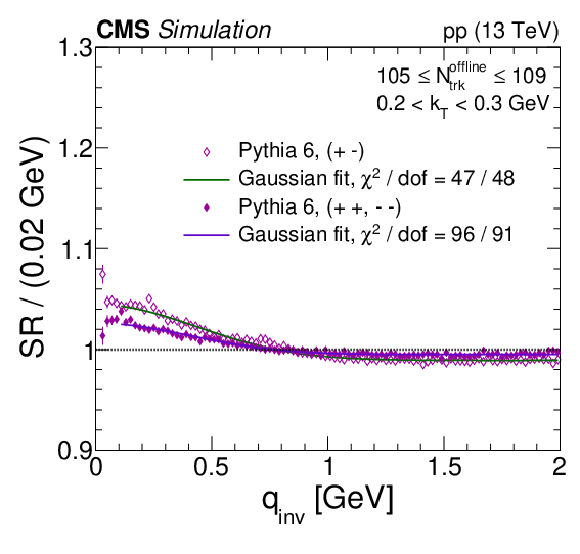
png pdf |
Figure 1-d:
The same-sign ($++,-$) and opposite-sign ($+-$) single ratios employing PYTHIA 6 (Z2* tune) in bin 105 $ \leq N^\text {offline}_\text {trk} \leq $ 109 and 0.2 $ < {k_{\mathrm {T}}} \leq $ 0.3 GeV with the Gaussian fit from Eq. (4). The following $ {q_\text {inv}} $ ranges are excluded from the fits: 0.2 $ < {q_\text {inv}} < $ 0.3, 0.4 $ < {q_\text {inv}} < $ 0.9, and 0.95 $ < {q_\text {inv}} < $ 1.2 GeV. Coulomb interactions are not included in the simulation. The error bars represent statistical uncertainties and in most cases are smaller than the marker size. |
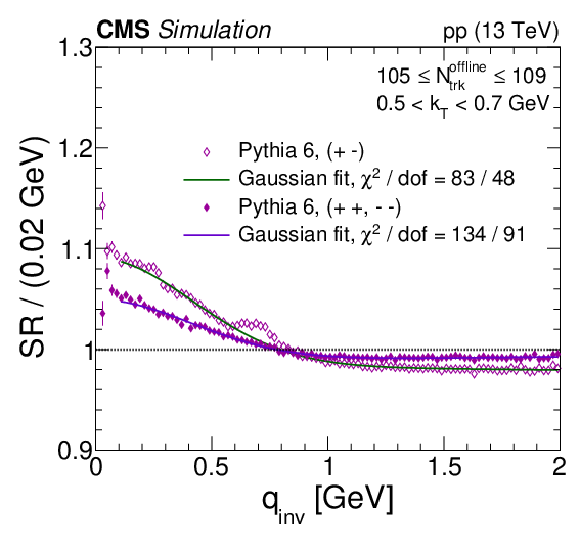
png pdf |
Figure 1-e:
The same-sign ($++,-$) and opposite-sign ($+-$) single ratios employing PYTHIA 6 (Z2* tune) in bin 105 $ \leq N^\text {offline}_\text {trk} \leq $ 109 and 0.5 $ < {k_{\mathrm {T}}} \leq $ 0.7 GeV with the Gaussian fit from Eq. (4). The following $ {q_\text {inv}} $ ranges are excluded from the fits: 0.2 $ < {q_\text {inv}} < $ 0.3, 0.4 $ < {q_\text {inv}} < $ 0.9, and 0.95 $ < {q_\text {inv}} < $ 1.2 GeV. Coulomb interactions are not included in the simulation. The error bars represent statistical uncertainties and in most cases are smaller than the marker size. |
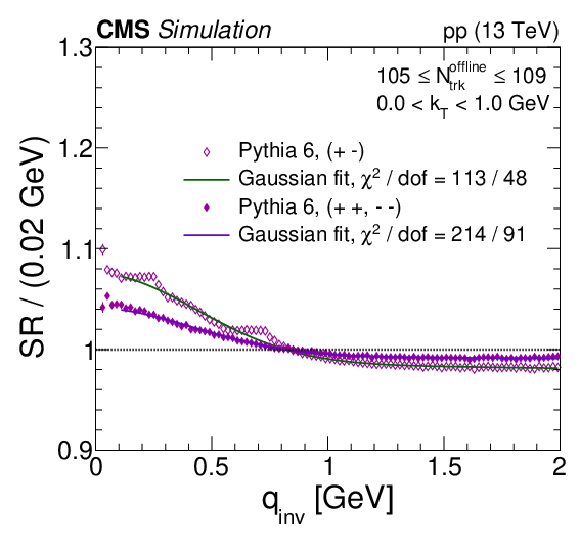
png pdf |
Figure 1-f:
The same-sign ($++,-$) and opposite-sign ($+-$) single ratios employing PYTHIA 6 (Z2* tune) in bin 105 $ \leq N^\text {offline}_\text {trk} \leq $ 109 and 0 $ < {k_{\mathrm {T}}} \leq $ 1 GeV with the Gaussian fit from Eq. (4). The following $ {q_\text {inv}} $ ranges are excluded from the fits: 0.2 $ < {q_\text {inv}} < $ 0.3, 0.4 $ < {q_\text {inv}} < $ 0.9, and 0.95 $ < {q_\text {inv}} < $ 1.2 GeV. Coulomb interactions are not included in the simulation. The error bars represent statistical uncertainties and in most cases are smaller than the marker size. |
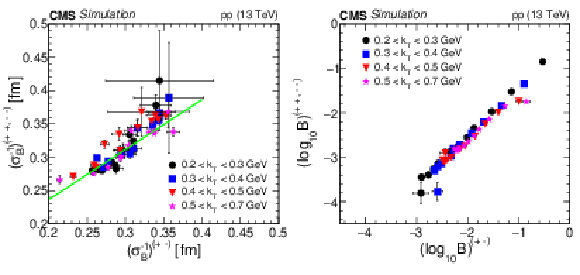
png pdf |
Figure 2:
Relations between same-sign ($++,-$) and opposite-sign ($+-$) fit parameters from Eq. (4), as a function of $ {k_{\mathrm {T}}} $ and $N^\text {offline}_\text {trk}$ for events in MB (i.e., higher $\sigma _{\text {B}}^{-1}$ and lower $\text {log}_{10}\text {B}$) and HM (i.e., lower $\sigma _{\text {B}}^{-1}$ and higher $\text {log}_{10}\text {B}$) ranges. The fit values found for the parameters corresponding to the peak's width (left) and the amplitude (right) of the same-sign and opposite-sign correlations are shown. For a given $ {k_{\mathrm {T}}} $ range, each point represents an $N^\text {offline}_\text {trk}$ bin. The line in the left plot is a linear fit to all the data. The error bars represent statistical uncertainties. |
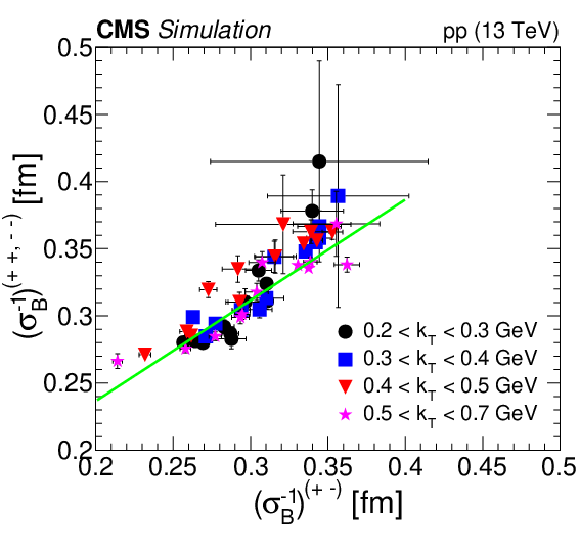
png pdf |
Figure 2-a:
Relations between same-sign ($++,-$) and opposite-sign ($+-$) fit parameters from Eq. (4), as a function of $ {k_{\mathrm {T}}} $ and $N^\text {offline}_\text {trk}$ for events in MB (i.e., higher $\sigma _{\text {B}}^{-1}$ and lower $\text {log}_{10}\text {B}$) and HM (i.e., lower $\sigma _{\text {B}}^{-1}$ and higher $\text {log}_{10}\text {B}$) ranges. The fit values found for the parameters corresponding to the peak's width of the same-sign and opposite-sign correlations are shown. For a given $ {k_{\mathrm {T}}} $ range, each point represents an $N^\text {offline}_\text {trk}$ bin. The line is a linear fit to all the data. The error bars represent statistical uncertainties. |

png pdf |
Figure 2-b:
Relations between same-sign ($++,-$) and opposite-sign ($+-$) fit parameters from Eq. (4), as a function of $ {k_{\mathrm {T}}} $ and $N^\text {offline}_\text {trk}$ for events in MB (i.e., higher $\sigma _{\text {B}}^{-1}$ and lower $\text {log}_{10}\text {B}$) and HM (i.e., lower $\sigma _{\text {B}}^{-1}$ and higher $\text {log}_{10}\text {B}$) ranges. The fit values found for the parameters corresponding to the peak's amplitude of the same-sign and opposite-sign correlations are shown. For a given $ {k_{\mathrm {T}}} $ range, each point represents an $N^\text {offline}_\text {trk}$ bin. The error bars represent statistical uncertainties. |
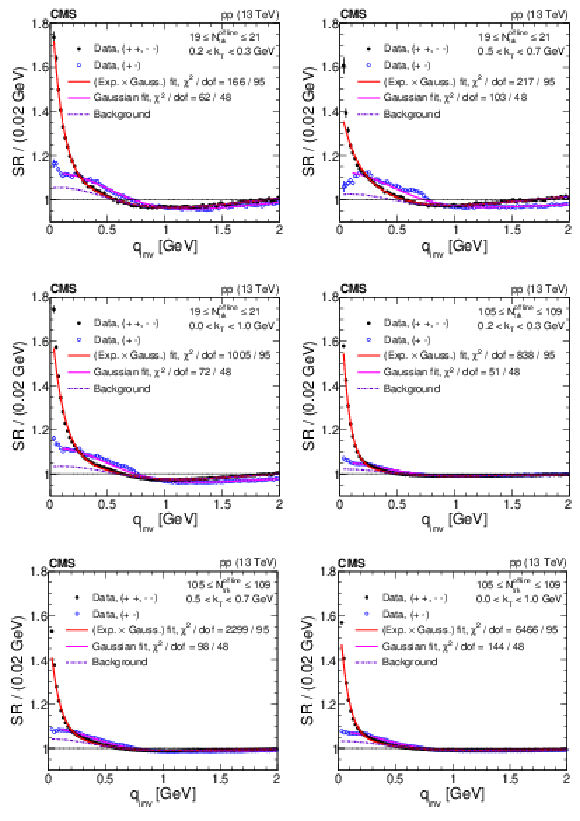
png pdf |
Figure 3:
The same-sign ($++,-$) and opposite-sign ($+-$) single ratios in data for different bins of $N^\text {offline}_\text {trk}$ and $ {k_{\mathrm {T}}} $, with their respective fits. The label "(Exp. $\times $ Gauss.) fit'' refers to the same-sign data and is given by Eq. (7). The label "Gaussian fit'' corresponds to Eq. (4) applied to opposite-sign data and "Background'' is the component of Eq. (7) that is found from the Gaussian fit using Eqs. (5) and (6) to convert the fit parameters. Coulomb corrections are accounted for using the Gamow factor. The error bars represent statistical uncertainties and in most cases are smaller than the marker size. |
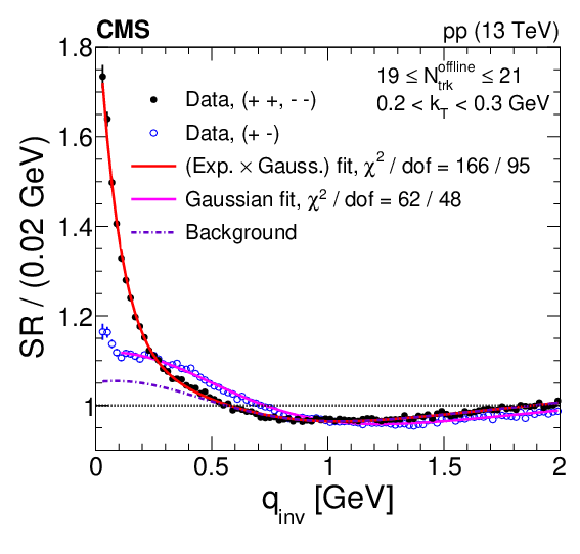
png pdf |
Figure 3-a:
The same-sign ($++,-$) and opposite-sign ($+-$) single ratios in data for bin 19 $ \leq N^\text {offline}_\text {trk} \leq $ 21 and 0.2 $ < {k_{\mathrm {T}}} \leq $ 0.3 GeV, with fit. The label "(Exp. $\times $ Gauss.) fit'' refers to the same-sign data and is given by Eq. (7). The label "Gaussian fit'' corresponds to Eq. (4) applied to opposite-sign data and "Background'' is the component of Eq. (7) that is found from the Gaussian fit using Eqs. (5) and (6) to convert the fit parameters. Coulomb corrections are accounted for using the Gamow factor. The error bars represent statistical uncertainties and in most cases are smaller than the marker size. |

png pdf |
Figure 3-b:
The same-sign ($++,-$) and opposite-sign ($+-$) single ratios in data for bin 19 $ \leq N^\text {offline}_\text {trk} \leq $ 21 and 0.5 $ < {k_{\mathrm {T}}} \leq $ 0.7 GeV, with fit. The label "(Exp. $\times $ Gauss.) fit'' refers to the same-sign data and is given by Eq. (7). The label "Gaussian fit'' corresponds to Eq. (4) applied to opposite-sign data and "Background'' is the component of Eq. (7) that is found from the Gaussian fit using Eqs. (5) and (6) to convert the fit parameters. Coulomb corrections are accounted for using the Gamow factor. The error bars represent statistical uncertainties and in most cases are smaller than the marker size. |

png pdf |
Figure 3-c:
The same-sign ($++,-$) and opposite-sign ($+-$) single ratios in data for bin 19 $ \leq N^\text {offline}_\text {trk} \leq $ 21 and 0 $ < {k_{\mathrm {T}}} \leq $ 1 GeV, with fit. The label "(Exp. $\times $ Gauss.) fit'' refers to the same-sign data and is given by Eq. (7). The label "Gaussian fit'' corresponds to Eq. (4) applied to opposite-sign data and "Background'' is the component of Eq. (7) that is found from the Gaussian fit using Eqs. (5) and (6) to convert the fit parameters. Coulomb corrections are accounted for using the Gamow factor. The error bars represent statistical uncertainties and in most cases are smaller than the marker size. |
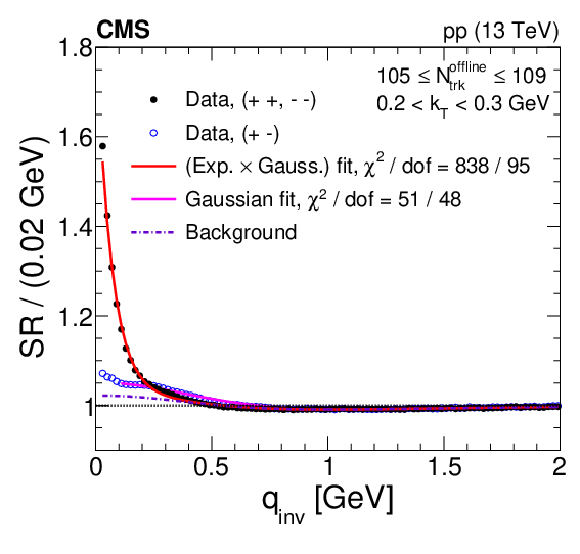
png pdf |
Figure 3-d:
The same-sign ($++,-$) and opposite-sign ($+-$) single ratios in data for bin 105 $ \leq N^\text {offline}_\text {trk} \leq $ 109 and 0.2 $ < {k_{\mathrm {T}}} \leq $ 0.3 GeV, with fit. The label "(Exp. $\times $ Gauss.) fit'' refers to the same-sign data and is given by Eq. (7). The label "Gaussian fit'' corresponds to Eq. (4) applied to opposite-sign data and "Background'' is the component of Eq. (7) that is found from the Gaussian fit using Eqs. (5) and (6) to convert the fit parameters. Coulomb corrections are accounted for using the Gamow factor. The error bars represent statistical uncertainties and in most cases are smaller than the marker size. |
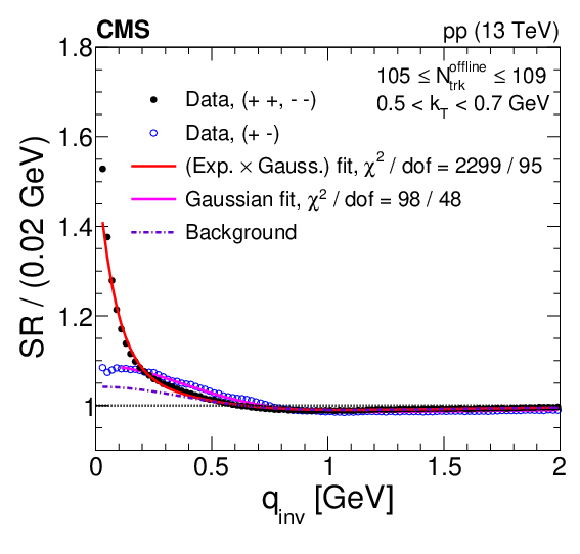
png pdf |
Figure 3-e:
The same-sign ($++,-$) and opposite-sign ($+-$) single ratios in data for bin 105 $ \leq N^\text {offline}_\text {trk} \leq $ 109 and 0.5 $ < {k_{\mathrm {T}}} \leq $ 0.7 GeV, with fit. The label "(Exp. $\times $ Gauss.) fit'' refers to the same-sign data and is given by Eq. (7). The label "Gaussian fit'' corresponds to Eq. (4) applied to opposite-sign data and "Background'' is the component of Eq. (7) that is found from the Gaussian fit using Eqs. (5) and (6) to convert the fit parameters. Coulomb corrections are accounted for using the Gamow factor. The error bars represent statistical uncertainties and in most cases are smaller than the marker size. |

png pdf |
Figure 3-f:
The same-sign ($++,-$) and opposite-sign ($+-$) single ratios in data for bin 105 $ \leq N^\text {offline}_\text {trk} \leq $ 109 and 0 $ < {k_{\mathrm {T}}} \leq $ 1 GeV, with fit. The label "(Exp. $\times $ Gauss.) fit'' refers to the same-sign data and is given by Eq. (7). The label "Gaussian fit'' corresponds to Eq. (4) applied to opposite-sign data and "Background'' is the component of Eq. (7) that is found from the Gaussian fit using Eqs. (5) and (6) to convert the fit parameters. Coulomb corrections are accounted for using the Gamow factor. The error bars represent statistical uncertainties and in most cases are smaller than the marker size. |

png pdf |
Figure 4:
Results for $ {R_\text {inv}} $ (left) and $\lambda $ (right) from the three methods as a function of multiplicity (upper) and $ {k_{\mathrm {T}}} $ (lower). In the upper plots, statistical and systematic uncertainties are represented by internal and external error bars, respectively. In the lower plots, statistical and systematic uncertainties are shown as error bars and open boxes, respectively. |
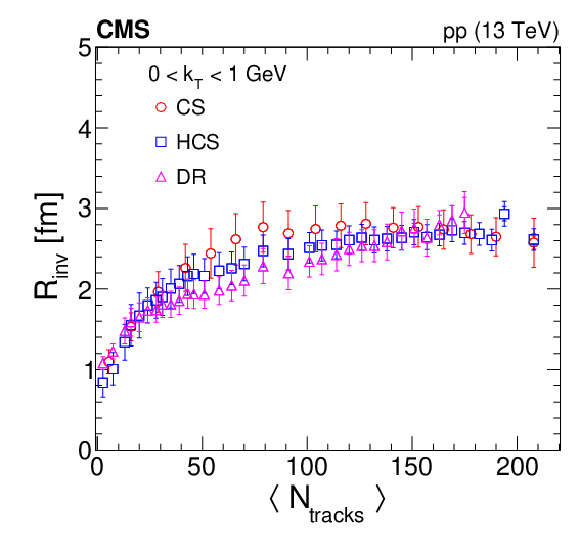
png pdf |
Figure 4-a:
Result for $ {R_\text {inv}} $ from the three methods as a function of multiplicity. Statistical and systematic uncertainties are represented by internal and external error bars, respectively. |

png pdf |
Figure 4-b:
Result for $\lambda $ from the three methods as a function of $ {k_{\mathrm {T}}} $. Statistical and systematic uncertainties are represented by internal and external error bars, respectively. |
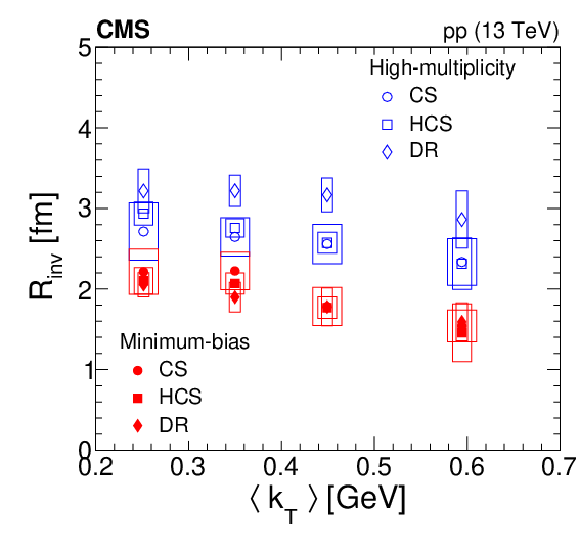
png pdf |
Figure 4-c:
Result for $ {R_\text {inv}} $ from the three methods as a function of multiplicity. Statistical and systematic uncertainties are shown as error bars and open boxes, respectively. |
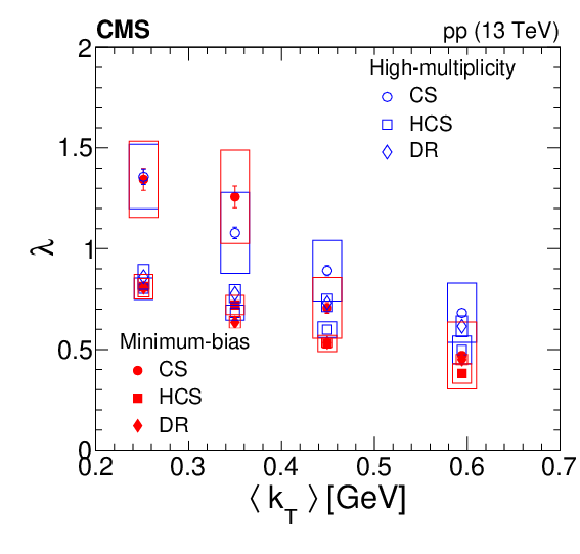
png pdf |
Figure 4-d:
Result for $\lambda $ from the three methods as a function of $ {k_{\mathrm {T}}} $. Statistical and systematic uncertainties are shown as error bars and open boxes, respectively. |

png pdf |
Figure 5:
The $ {R_\text {inv}} $ fit parameters as a function of particle-level multiplicities using the HCS method in pp collisions at 13 TeV compared to results for pp collisions at 7 TeV from CMS (left) and ATLAS (right). Both the ordinate and abscissa for the CMS data in the right plot have been adjusted for compatibility with the ATLAS analysis procedure, as explained in the text. The error bars in the CMS [5] case represent systematic uncertainties (statistical uncertainties are smaller than the marker size) and in the ATLAS [15] case, statistical and systematic uncertainties added in quadrature. |

png pdf |
Figure 5-a:
The $ {R_\text {inv}} $ fit parameters as a function of particle-level multiplicities using the HCS method in pp collisions at 13 TeV compared to results for pp collisions at 7 TeV from CMS. The error bars represent systematic uncertainties (statistical uncertainties are smaller than the marker size). |
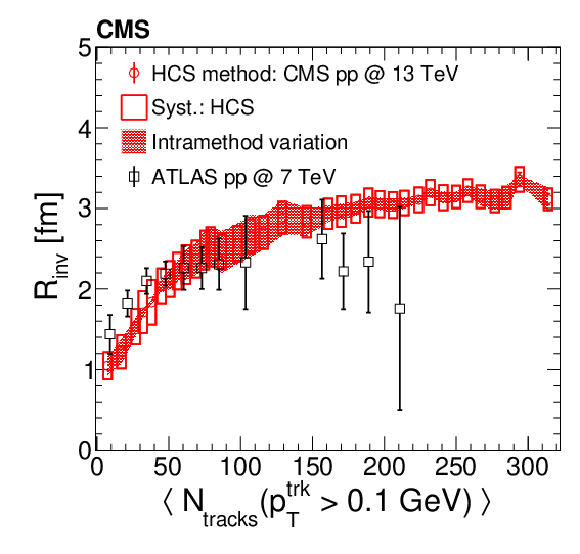
png pdf |
Figure 5-b:
The $ {R_\text {inv}} $ fit parameters as a function of particle-level multiplicities using the HCS method in pp collisions at 13 TeV compared to results for pp collisions at 7 TeV from ATLAS. Both the ordinate and abscissa for the CMS data have been adjusted for compatibility with the ATLAS analysis procedure, as explained in the text. In the ATLAS [15] case, statistical and systematic uncertainties added in quadrature. |
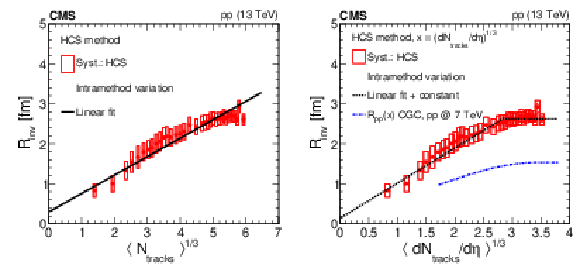
png pdf |
Figure 6:
Comparison of $ {R_\text {inv}} $ obtained with the HCS method with theoretical expectations. Values of $ {R_\text {inv}} $ as a function of $< N_\text {tracks}> ^{1/3}$ (left) are shown with a linear fit to illustrate the expectation from hydrodynamics. Values of $ {R_\text {inv}} $ are compared with predictions from the CGC as a function of $< {\mathrm {d}}N_\text {tracks}/ {\mathrm {d}}\eta > ^{1/3}$ (right). The dot-dashed blue line is the result of the parameterization in Eq. (8). The linear plus constant function (dashed black lines) for $< {\mathrm {d}}N_\text {tracks}/ {\mathrm {d}}\eta > ^{1/3}$ is shown to illustrate the qualitative behavior suggested by the CGC (the matching point of the two lines is the result of a fit). Only statistical uncertainties are considered. |
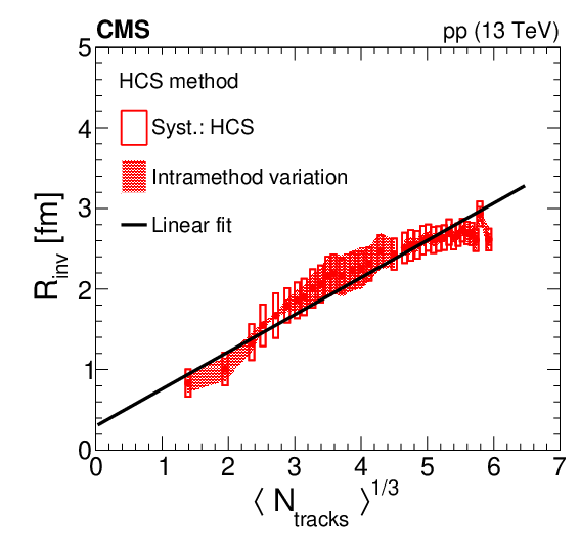
png pdf |
Figure 6-a:
Comparison of $ {R_\text {inv}} $ obtained with the HCS method with theoretical expectations. Values of $ {R_\text {inv}} $ as a function of $< N_\text {tracks}> ^{1/3}$ are shown with a linear fit to illustrate the expectation from hydrodynamics. |
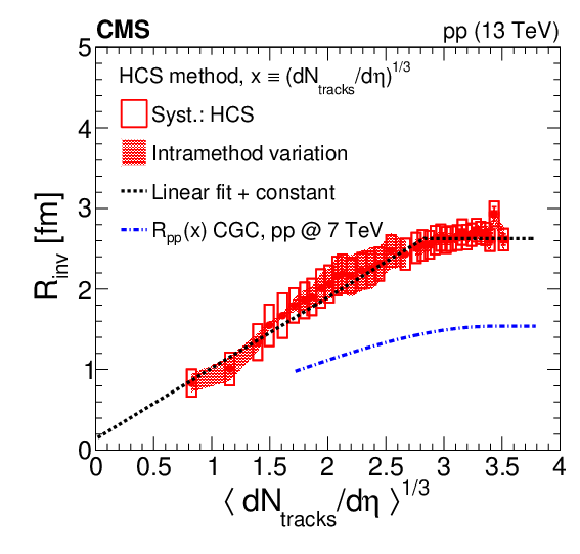
png pdf |
Figure 6-b:
Comparison of $ {R_\text {inv}} $ obtained with the HCS method with theoretical expectations. Values of $ {R_\text {inv}} $ are compared with predictions from the CGC as a function of $< {\mathrm {d}}N_\text {tracks}/ {\mathrm {d}}\eta > ^{1/3}$. The dot-dashed blue line is the result of the parameterization in Eq. (8). The linear plus constant function (dashed black lines) for $< {\mathrm {d}}N_\text {tracks}/ {\mathrm {d}}\eta > ^{1/3}$ is shown to illustrate the qualitative behavior suggested by the CGC (the matching point of the two lines is the result of a fit). Only statistical uncertainties are considered. |
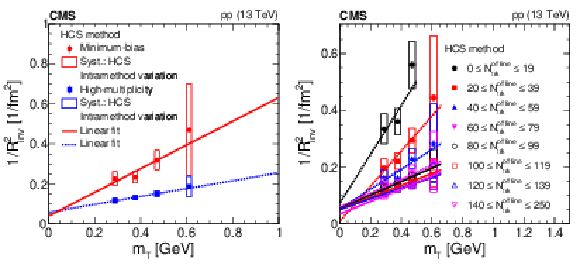
png pdf |
Figure 7:
The distribution $1/R_{\text {inv}}^2$ as a function of $ {m_{\mathrm {T}}} $ for the HCS method. Results corresponding to the MB range (0 $ \le N_\text {trk}^\text {offline} \le $ 79) and to the HM one (80 $ \le N_\text {trk}^\text {offline} \le $ 250) are shown (left). Results are also shown in more differential bins of multiplicity (right). Statistical uncertainties are represented by the error bars, systematic uncertainties related to the HCS method are shown as open boxes, and the relative uncertainties from the intramethods variation are represented by the shaded bands. Only statistical uncertainties are considered in all the fits. |
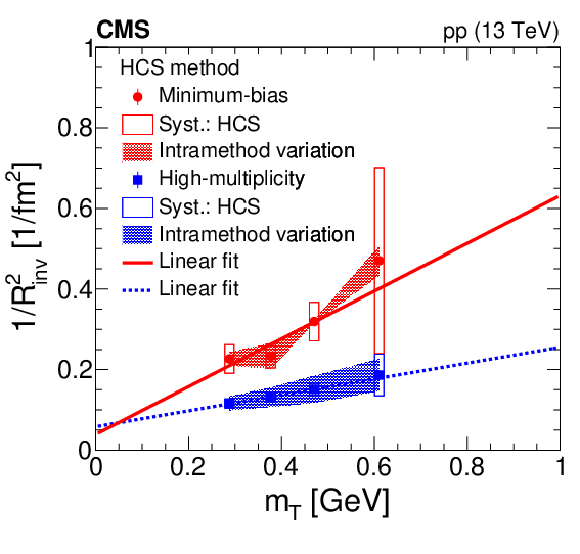
png pdf |
Figure 7-a:
The distribution $1/R_{\text {inv}}^2$ as a function of $ {m_{\mathrm {T}}} $ for the HCS method. Results corresponding to the MB range (0 $ \le N_\text {trk}^\text {offline} \le $ 79) and to the HM one (80 $ \le N_\text {trk}^\text {offline} \le $ 250) are shown. Statistical uncertainties are represented by the error bars, systematic uncertainties related to the HCS method are shown as open boxes, and the relative uncertainties from the intramethods variation are represented by the shaded bands. Only statistical uncertainties are considered in all the fits. |
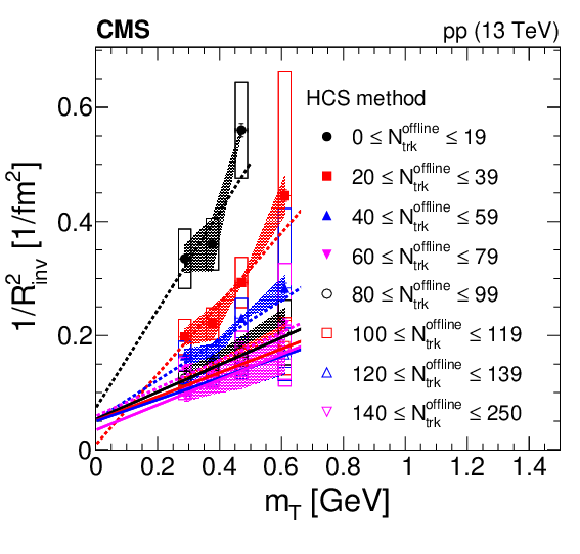
png pdf |
Figure 7-b:
The distribution $1/R_{\text {inv}}^2$ as a function of $ {m_{\mathrm {T}}} $ for the HCS method. Results are shown in bins of multiplicity. Statistical uncertainties are represented by the error bars, systematic uncertainties related to the HCS method are shown as open boxes, and the relative uncertainties from the intramethods variation are represented by the shaded bands. Only statistical uncertainties are considered in all the fits. |

png pdf |
Figure 8:
Illustration of the steps in the double ratio method. The single ratio in data is constructed (left), followed by a similar procedure with simulated events (PYTHIA 6, Z2* tune). The ratio of the two curves on the left defines the double ratio (right). The reference sample is obtained with the $\eta $-mixing procedure. All results correspond to integrated values in $N^\text {offline}_\text {trk}$ and $ {k_{\mathrm {T}}} $. |
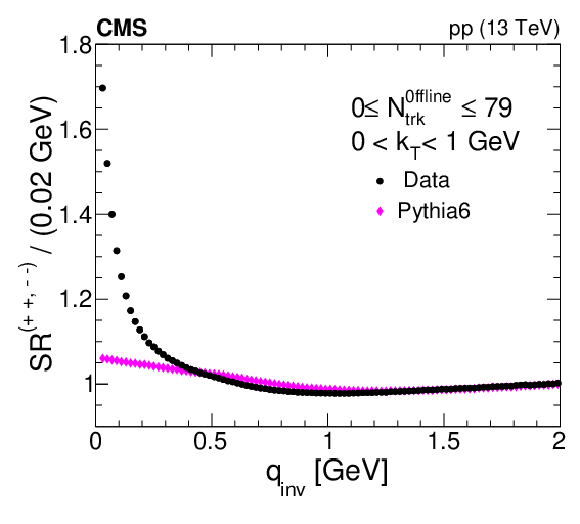
png pdf |
Figure 8-a:
Illustration of the steps in the double ratio method. The single ratio in data is constructed, followed by a similar procedure with simulated events (PYTHIA 6, Z2* tune). The reference sample is obtained with the $\eta $-mixing procedure. All results correspond to integrated values in $N^\text {offline}_\text {trk}$ and $ {k_{\mathrm {T}}} $. |

png pdf |
Figure 8-b:
Illustration of the steps in the double ratio method. The ratio of the two curves in Fig. 8-a defines the double ratio. The reference sample is obtained with the $\eta $-mixing procedure. All results correspond to integrated values in $N^\text {offline}_\text {trk}$ and $ {k_{\mathrm {T}}} $. |

png pdf |
Figure 9:
The same-sign ($++,-$) and opposite-sign ($+-$) single ratios are shown in different $N^\text {offline}_\text {trk}$ and $ {k_{\mathrm {T}}} $ bins, together with the full fits (continuous curves) given in Eqs. (10) and (13), for minimum-bias (upper row) and HM (lower row) events. The error bars represent statistical uncertainties and in most cases are smaller than the marker size. |
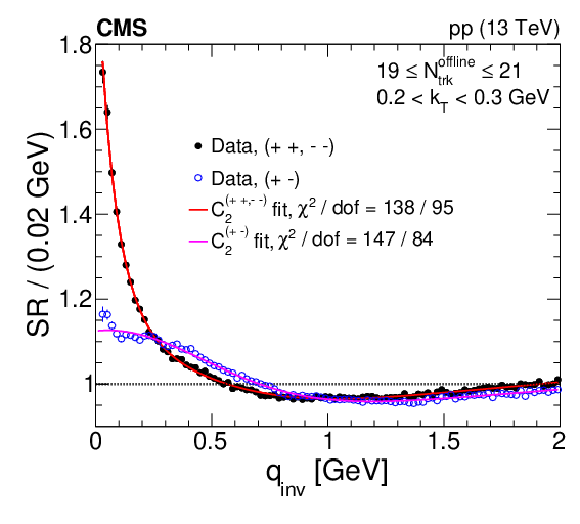
png pdf |
Figure 9-a:
The same-sign ($++,-$) and opposite-sign ($+-$) single ratios are shown in bin 19 $ \leq N^\text {offline}_\text {trk} \leq $ 21 and 0.2 $ < {k_{\mathrm {T}}} \leq $ 0.3 GeV, together with the full fit (continuous curve) given in Eqs. (10) and (13), for minimum-bias events. The error bars represent statistical uncertainties and in most cases are smaller than the marker size. |

png pdf |
Figure 9-b:
The same-sign ($++,-$) and opposite-sign ($+-$) single ratios are shown in bin 19 $ \leq N^\text {offline}_\text {trk} \leq $ 21 and 0.5 $ < {k_{\mathrm {T}}} \leq $ 0.7 GeV, together with the full fit (continuous curve) given in Eqs. (10) and (13), for minimum-bias events. The error bars represent statistical uncertainties and in most cases are smaller than the marker size. |
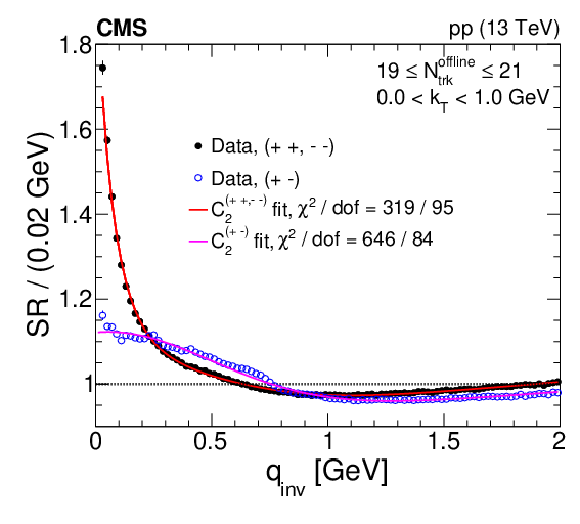
png pdf |
Figure 9-c:
The same-sign ($++,-$) and opposite-sign ($+-$) single ratios are shown in bin 19 $ \leq N^\text {offline}_\text {trk} \leq $ 21 and 0 $ < {k_{\mathrm {T}}} \leq $ 1 GeV, together with the full fit (continuous curve) given in Eqs. (10) and (13), for minimum-bias events. The error bars represent statistical uncertainties and in most cases are smaller than the marker size. |

png pdf |
Figure 9-d:
The same-sign ($++,-$) and opposite-sign ($+-$) single ratios are shown in bin 105 $ \leq N^\text {offline}_\text {trk} \leq $ 109 and 0.2 $ < {k_{\mathrm {T}}} \leq $ 0.3 GeV, together with the full fit (continuous curve) given in Eqs. (10) and (13), for HM events. The error bars represent statistical uncertainties and in most cases are smaller than the marker size. |

png pdf |
Figure 9-e:
The same-sign ($++,-$) and opposite-sign ($+-$) single ratios are shown in bin 105 $ \leq N^\text {offline}_\text {trk} \leq $ 109 and 0.5 $ < {k_{\mathrm {T}}} \leq $ 0.7 GeV, together with the full fit (continuous curve) given in Eqs. (10) and (13), for HM events. The error bars represent statistical uncertainties and in most cases are smaller than the marker size. |
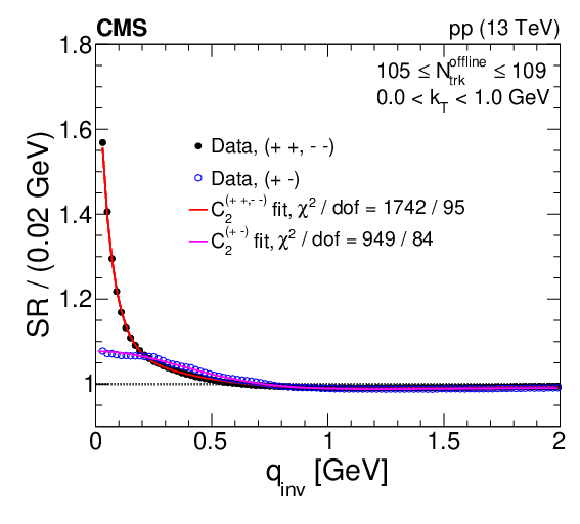
png pdf |
Figure 9-f:
The same-sign ($++,-$) and opposite-sign ($+-$) single ratios are shown in bin 105 $ \leq N^\text {offline}_\text {trk} \leq $ 109 and 0 $ < {k_{\mathrm {T}}} \leq $ 1 GeV, together with the full fit (continuous curve) given in Eqs. (10) and (13), for HM events. The error bars represent statistical uncertainties and in most cases are smaller than the marker size. |
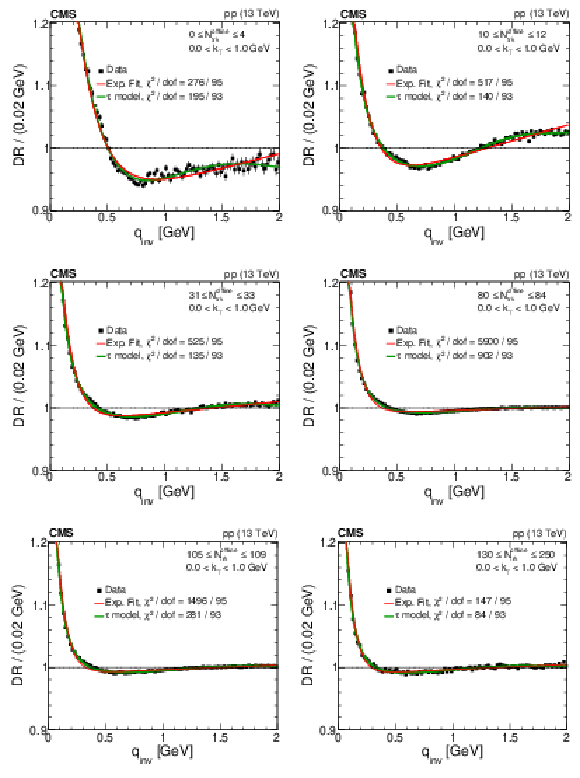
png pdf |
Figure 10:
Correlation functions from the double ratio technique, integrated in the range 0 $ < {k_{\mathrm {T}}} < $ 1 GeV, in six multiplicity bins. The results are zoomed along the vertical axis. The error bars represent statistical uncertainties and in most cases are smaller than the marker size. |

png pdf |
Figure 10-a:
Correlation functions from the double ratio technique, integrated in the range 0 $ < {k_{\mathrm {T}}} < $ 1 GeV, in multiplicity bin 0 $ \leq N^\text {offline}_\text {trk} \leq $ 4. The results are zoomed along the vertical axis. The error bars represent statistical uncertainties and in most cases are smaller than the marker size. |

png pdf |
Figure 10-b:
Correlation functions from the double ratio technique, integrated in the range 0 $ < {k_{\mathrm {T}}} < $ 1 GeV, in multiplicity bin 10 $ \leq N^\text {offline}_\text {trk} \leq $ 12. The results are zoomed along the vertical axis. The error bars represent statistical uncertainties and in most cases are smaller than the marker size. |
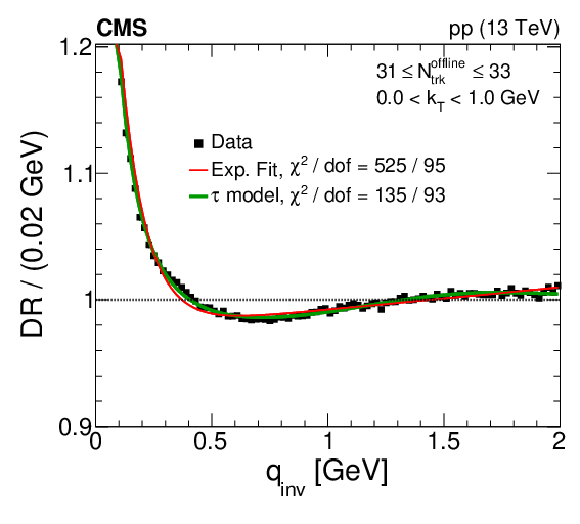
png pdf |
Figure 10-c:
Correlation functions from the double ratio technique, integrated in the range 0 $ < {k_{\mathrm {T}}} < $ 1 GeV, in multiplicity bin 31 $ \leq N^\text {offline}_\text {trk} \leq $ 33. The results are zoomed along the vertical axis. The error bars represent statistical uncertainties and in most cases are smaller than the marker size. |
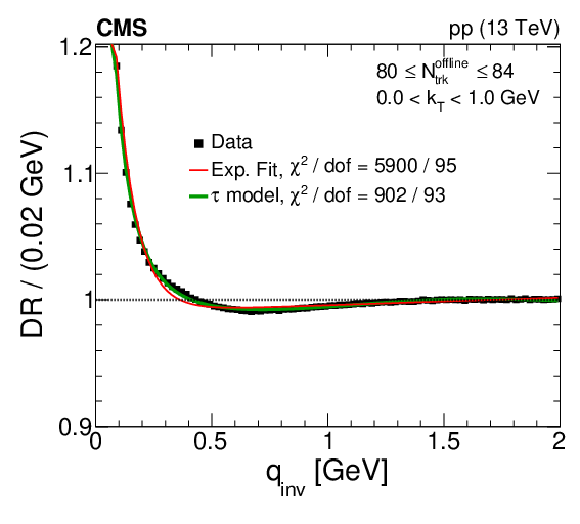
png pdf |
Figure 10-d:
Correlation functions from the double ratio technique, integrated in the range 0 $ < {k_{\mathrm {T}}} < $ 1 GeV, in multiplicity bin 80 $ \leq N^\text {offline}_\text {trk} \leq $ 84. The results are zoomed along the vertical axis. The error bars represent statistical uncertainties and in most cases are smaller than the marker size. |

png pdf |
Figure 10-e:
Correlation functions from the double ratio technique, integrated in the range 0 $ < {k_{\mathrm {T}}} < $ 1 GeV, in multiplicity bin 105 $ \leq N^\text {offline}_\text {trk} \leq $ 109. The results are zoomed along the vertical axis. The error bars represent statistical uncertainties and in most cases are smaller than the marker size. |
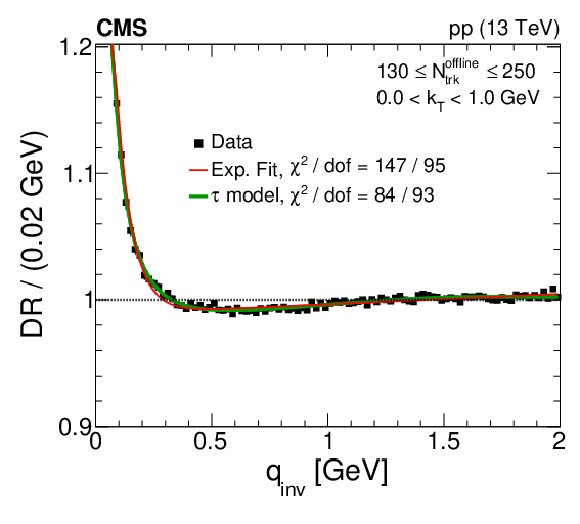
png pdf |
Figure 10-f:
Correlation functions from the double ratio technique, integrated in the range 0 $ < {k_{\mathrm {T}}} < $ 1 GeV, in multiplicity bin 130 $ \leq N^\text {offline}_\text {trk} \leq $ 250. The results are zoomed along the vertical axis. The error bars represent statistical uncertainties and in most cases are smaller than the marker size. |

png pdf |
Figure 11:
The depth of the anticorrelation $\Delta $ is shown as a function of multiplicity (left) for $ {k_{\mathrm {T}}} $-integrated values. The fit parameter $\Delta $ is also shown in finer bins of $N_\text {tracks}$ and $ {k_{\mathrm {T}}} $ (right). The statistical uncertainties are represented by the error bars, while the systematic ones are represented by the open boxes. |
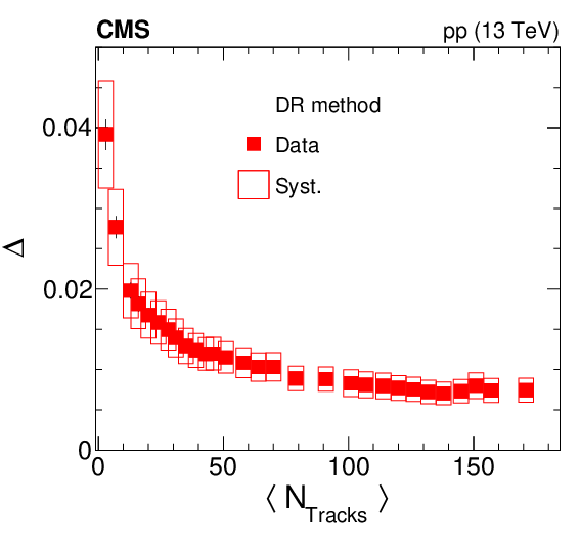
png pdf |
Figure 11-a:
The depth of the anticorrelation $\Delta $ is shown as a function of multiplicity for $ {k_{\mathrm {T}}} $-integrated values. The statistical uncertainties are represented by the error bars, while the systematic ones are represented by the open boxes. |
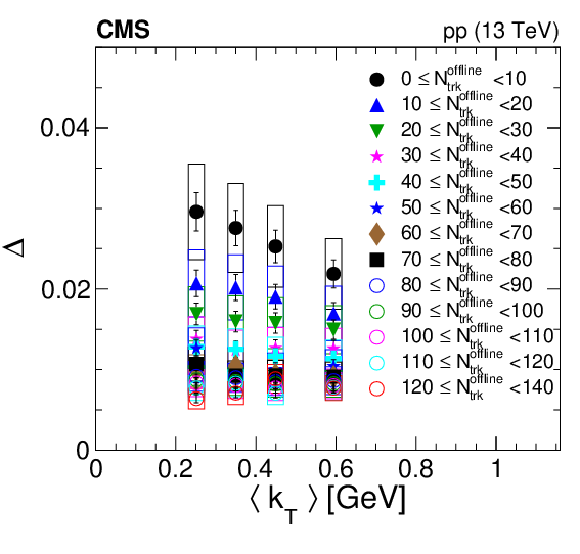
png pdf |
Figure 11-b:
The fit parameter $\Delta $ is shown in fine bins of $N_\text {tracks}$ and $ {k_{\mathrm {T}}} $. The statistical uncertainties are represented by the error bars, while the systematic ones are represented by the open boxes. |
| Tables | |
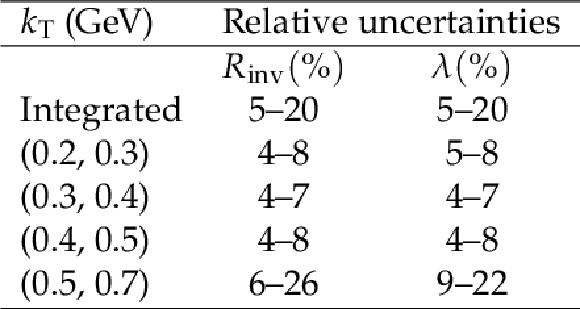
png pdf |
Table 1:
Total systematic uncertainties in different $ {k_{\mathrm {T}}} $ bins for the hybrid cluster subtraction technique. The ranges in the uncertainties indicate the minimum and maximum values found for all multiplicity bins. |

png pdf |
Table 2:
Values of the fit parameters from Eqs. (11) and (12), describing the cluster contribution in the data OS correlation function. The estimated uncertainty in the parameters is about 10%. |
| Summary |
|
A Bose-Einstein correlation measurement is reported using data collected with the CMS detector at the LHC in proton-proton collisions at $\sqrt{s} = $ 13 TeV, covering a broad range of charged particle multiplicity, from a few particles up to 250 reconstructed charged hadrons. Three analysis methods, each with a different dependence on Monte Carlo simulations, are used to generate correlation functions, which are found to give consistent results. One dimensional studies of the radius fit parameter, $R_{\text{inv}}$, and the intercept parameter, $\lambda$, have been carried out for both inclusive events and high multiplicity events selected using a dedicated online trigger. For multiplicities in the range 0 $ < N_{\text{trk}}^{\text{offline}} < $ 250 and average pair transverse momentum 0 $ < {k_{\mathrm{T}}} < $ 1 GeV, values of the radius fit parameter and intercept are in the ranges 0.8 $ < R_{\text{inv}} < $ 3.0 fm and 0.5 $ < \lambda < $ 1.0, respectively. Over most of the multiplicity range studied, the value of $R_{\text{inv}}$ increases with increasing event multiplicities and is proportional to $ < N_{\text{tracks}} > ^{1/3} $, a trend which is predicted by hydrodynamical calculations. For events with more than ${\sim}$ 100 charged particles, the observed dependence of $R_{\text{inv}}$ suggests a possible saturation, with the lengths of homogeneity also consistent with a constant value. Comparisons of the multiplicity dependence are made with predictions of the color glass condensate effective theory, by means of a parameterization of the radius of the system formed in pp collisions. The values of the radius parameters in the model are much lower than those in the data, although the general shape of the dependence on multiplicity is similar in both cases. The radius fit parameter $R_{\text{inv}}$ is also observed to decrease with increasing ${k_{\mathrm{T}}}$, a behavior that is consistent with emission from a system that is expanding prior to its decoupling. Inspired by hydrodynamic models, the dependence of $R_{\text{inv}}^{-2}$ on the average pair transverse mass was investigated and the two are observed to be proportional, a behavior similar to that seen in nucleus-nucleus collisions. The proportionality constant between $R_{\text{inv}}^{-2}$ and transverse mass can be related to the flow parameter of a Hubble-type expansion of the system. For pp collisions at 13 TeV, this expansion is slower for larger event multiplicity, a dependence that was also found in nucleus-nucleus collisions. Therefore, the present analysis reveals additional similarities between the systems produced in high multiplicity pp collisions and those found using data for larger initial systems. These results may provide additional constraints on future attempts using hydrodynamical models and/or the color glass condensate framework to explain the entire range of similarities between pp and heavy ion interactions. |
| Additional Figures | |

png pdf |
Additional Figure 1:
Unzoomed correlation functions from the double ratio technique, integrated in the range 0 $ < {k_{\mathrm {T}}} < $ 1 GeV, in multiplicity bins. The error bars represent statistical uncertainties and in most cases are smaller than the marker size. |

png pdf |
Additional Figure 1-a:
Unzoomed correlation functions from the double ratio technique, integrated in the range 0 $ < {k_{\mathrm {T}}} < $ 1 GeV, in multiplicity bin 0 $ \leq N^\text {offline}_\text {trk} \leq $ 4. The error bars represent statistical uncertainties and in most cases are smaller than the marker size. |
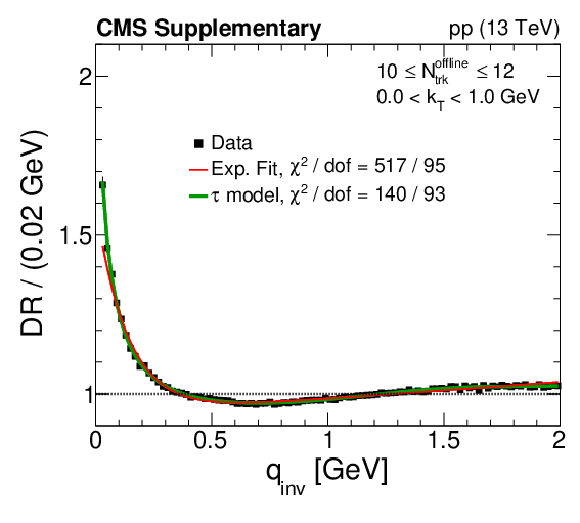
png pdf |
Additional Figure 1-b:
Unzoomed correlation functions from the double ratio technique, integrated in the range 0 $ < {k_{\mathrm {T}}} < $ 1 GeV, in multiplicity bin 10 $ \leq N^\text {offline}_\text {trk} \leq $ 12. The error bars represent statistical uncertainties and in most cases are smaller than the marker size. |
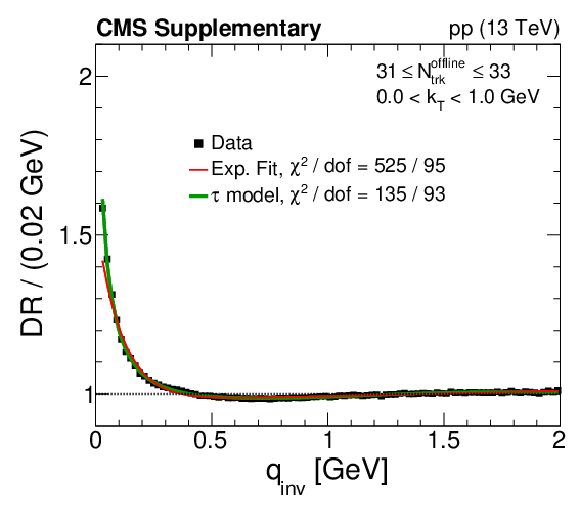
png pdf |
Additional Figure 1-c:
Unzoomed correlation functions from the double ratio technique, integrated in the range 0 $ < {k_{\mathrm {T}}} < $ 1 GeV, in multiplicity bin 31 $ \leq N^\text {offline}_\text {trk} \leq $ 33. The error bars represent statistical uncertainties and in most cases are smaller than the marker size. |

png pdf |
Additional Figure 1-d:
Unzoomed correlation functions from the double ratio technique, integrated in the range 0 $ < {k_{\mathrm {T}}} < $ 1 GeV, in multiplicity bin 80 $ \leq N^\text {offline}_\text {trk} \leq $ 84. The error bars represent statistical uncertainties and in most cases are smaller than the marker size. |
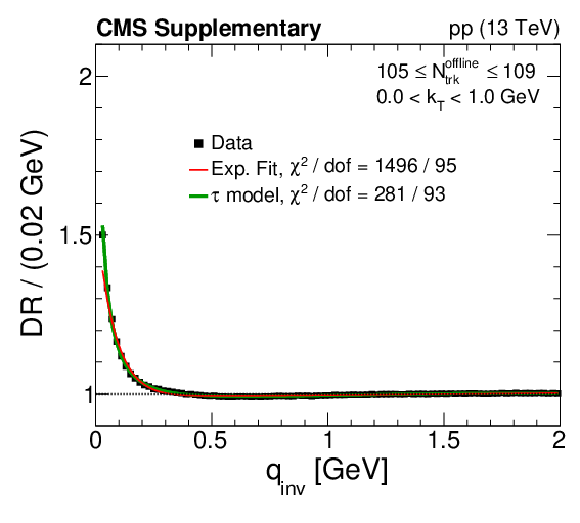
png pdf |
Additional Figure 1-e:
Unzoomed correlation functions from the double ratio technique, integrated in the range 0 $ < {k_{\mathrm {T}}} < $ 1 GeV, in multiplicity bin 105 $ \leq N^\text {offline}_\text {trk} \leq $ 109. The error bars represent statistical uncertainties and in most cases are smaller than the marker size. |

png pdf |
Additional Figure 1-f:
Unzoomed correlation functions from the double ratio technique, integrated in the range 0 $ < {k_{\mathrm {T}}} < $ 1 GeV, in multiplicity bin 130 $ \leq N^\text {offline}_\text {trk} \leq $ 250. The error bars represent statistical uncertainties and in most cases are smaller than the marker size. |
| References | ||||
| 1 | G. Goldhaber, S. Goldhaber, W. Lee and A. Pais | Influence of Bose-Einstein statistics in the antiproton-proton annihilation process | PR120 (1960) 300 | |
| 2 | M. A. Lisa, S. Pratt, R. Soltz, and U. Wiedemann | Femtoscopy in relativistic heavy ion collisions: two decades of progress | Annu. Rev. Nucl. Part. Sci. 55 (2005) 357 | nucl-ex/0505014 |
| 3 | CMS Collaboration | First measurement of Bose-Einstein correlations in proton-proton collisions at $ \sqrt{s} = $ 0.9 and 2.36 TeV at the LHC | PRL 105 (2010) 032001 | CMS-QCD-10-003 1005.3294 |
| 4 | CMS Collaboration | Measurement of Bose-Einstein correlations in pp collisions at $ \sqrt{s}= $ 0.9 and 7 TeV | JHEP 05 (2011) 029 | CMS-QCD-10-023 1101.3518 |
| 5 | CMS Collaboration | Bose-Einstein correlations in pp, pPb, and PbPb collisions at $ \sqrt{s} = $ 0.9--7 TeV | PRC 97 (2018) 064912 | CMS-FSQ-14-002 1712.07198 |
| 6 | AFS Collaboration | Bose-Esinstein correlations in $ \alpha \alpha $, $\mathrm{pp}$ and $ \mathrm{p}\overline{\mathrm{p}} $ interactions | PLB 129 (1983) 269 | |
| 7 | AFS Collaboration | Bose-Einstein correlations between kaons | PLB 155 (1985) 128 | |
| 8 | AFS Collaboration | Evidence of a directional dependence of Bose-Einstein correlations at the CERN Intersecting Storage Rings | PLB 187 (1987) 420 | |
| 9 | UA1 Collaboration | Bose-Einstein correlations in $ \mathrm{p}\overline{\mathrm{p}} $ interactions at $ \sqrt{s} = $ 0.2 to 0.9 TeV | PLB 226 (1989) 410 | |
| 10 | E735 Collaboration | Study of the source size in $ \mathrm{p \bar{p}} $ collisions at 1.8 TeV using pion interferometry | PRD 48 (1993) 1931 | |
| 11 | PHOBOS Collaboration | Transverse momentum and rapidity dependence of HBT correlations in Au+Au collisions at $ \sqrt{s_{\text{NN}}} = $ 62.4 GeV and 200 GeV | PRC 73 (2006) 031901 | nucl-ex/0409001 |
| 12 | STAR Collaboration | Pion interferometry in Au+Au collisions at $ \sqrt{s_{\text{NN}}} = $ 200 GeV | PRC 71 (2005) 044906 | nucl-ex/0411036 |
| 13 | PHENIX Collaboration | Source breakup dynamics in Au+Au collisions at $ \sqrt{s_{\text{NN}}} = $ 200 GeV via three-dimensional two-pion source imaging | PRL 100 (2008) 232301 | 0712.4372 |
| 14 | ALICE Collaboration | Two-pion Bose-Einstein correlations in pp collisions at $ \sqrt{s} = $ 900 GeV | PRD 82 (2010) 052001 | 1007.0516 |
| 15 | ATLAS Collaboration | Two-particle Bose-Einstein correlations in pp collisions at $ \sqrt{s}= $ 0.9 and 7 TeV with the ATLAS detector | EPJC 75 (2015) 466 | 1502.07947 |
| 16 | LHCb Collaboration | Bose-Einstein correlations of same-sign charged pions in the forward region in pp collisions at $ \sqrt{s} = $ 7 TeV | JHEP 12 (2017) 025 | 1709.01769 |
| 17 | CMS Collaboration | Observation of long-range near-side angular correlations in proton-proton collisions at the LHC | JHEP 09 (2010) 091 | CMS-QCD-10-002 1009.4122 |
| 18 | ATLAS Collaboration | Observation of long-range elliptic azimuthal anisotropies in $ \sqrt{s}= $ 13 and 2.76 TeV pp collisions with the ATLAS detector | PRL 116 (2016) 172301 | 1509.04776 |
| 19 | CMS Collaboration | Observation of long-range near-side angular correlations in pPb collisions at the LHC | PLB 718 (2013) 795 | CMS-HIN-12-015 1210.5482 |
| 20 | ALICE Collaboration | Long-range angular correlations on the near and away side in p-Pb collisions at $ \sqrt{s_{\text{NN}}}= $ 5.02 TeV | PLB 719 (2013) 29 | 1212.2001 |
| 21 | ATLAS Collaboration | Observation of associated near-side and away-side long-range correlations in $ \sqrt{s_{\text{NN}}}= $ 5.02 TeV proton-lead collisions with the ATLAS detector | PRL 110 (2013) 182302 | 1212.5198 |
| 22 | LHCb Collaboration | Measurements of long-range near-side angular correlations in $ \sqrt{s_{\text{\text{NN}}}}= $ 5 TeV proton-lead collisions in the forward region | PLB 762 (2016) 473 | 1512.00439 |
| 23 | CMS Collaboration | Evidence for collectivity in pp collisions at the LHC | PLB 765 (2017) 193 | CMS-HIN-16-010 1606.06198 |
| 24 | CMS Collaboration | Measurement of long-range near-side two-particle angular correlations in pp collisions at $ \sqrt s = $ 13 TeV | PRL 116 (2016) 172302 | CMS-FSQ-15-002 1510.03068 |
| 25 | K. Dusling, W. Li, and B. Schenke | Novel collective phenomena in high-energy proton-proton and proton-nucleus collisions | Int. J. Mod. Phys. E 25 (2016) 1630002 | 1509.07939 |
| 26 | A. N. Makhlin and Y. M. Sinyukov | The hydrodynamics of hadron matter under a pion interferometric microscope | Z. Phys. C 39 (1988) 69 | |
| 27 | CMS Collaboration | Description and performance of track and primary-vertex reconstruction with the CMS tracker | JINST 9 (2014) P10009 | CMS-TRK-11-001 1405.6569 |
| 28 | CMS Collaboration | The CMS trigger system | JINST 12 (2017) P01020 | CMS-TRG-12-001 1609.02366 |
| 29 | CMS Collaboration | The CMS experiment at the CERN LHC | JINST 3 (2008) S08004 | CMS-00-001 |
| 30 | T. Sjostrand, S. Mrenna, and P. Skands | PYTHIA 6.4 physics and manual | JHEP 05 (2006) 026 | hep-ph/0603175 |
| 31 | T. Sjostrand, S. Mrenna, and P. Z. Skands | A brief introduction to PYTHIA 8.1 | CPC 178 (2008) 852 | 0710.3820 |
| 32 | CMS Collaboration | Study of the underlying event at forward rapidity in pp collisions at $ \sqrt{s} = $ 0.9, 2.76, and 7 TeV | JHEP 04 (2013) 072 | CMS-FWD-11-003 1302.2394 |
| 33 | CMS Collaboration | Event generator tunes obtained from underlying event and multiparton scattering measurements | EPJC 76 (2016) 155 | CMS-GEN-14-001 1512.00815 |
| 34 | R. Corke and T. Sjöstrand | Interleaved parton showers and tuning prospects | JHEP 03 (2011) 032 | 1011.1759 |
| 35 | I. Pierog, T. Karpenko, E. Katzy, J. M. Yatsenko, and K. Werner | EPOS LHC: Test of collective hadronization with data measured at the CERN Large Hadron Collider | PRC 92 (2015) 034906 | 1306.0121 |
| 36 | Geant4 Collaboration | GEANT4--a simulation toolkit | NIMA 506 (2003) 250 | |
| 37 | CMS Collaboration | Measurement of transverse momentum relative to dijet systems in PbPb and pp collisions at $ \sqrt{s_{\mathrm{\text{NN}}}}= $ 2.76 TeV | JHEP 01 (2016) 006 | CMS-HIN-14-010 1509.09029 |
| 38 | CMS Collaboration | Study of the inclusive production of charged pions, kaons, and protons in pp collisions at $ \sqrt{s}= $ 0.9 , 2.76, and 7~TeV | EPJC 72 (2012) 2164 | CMS-FSQ-12-014 1207.4724 |
| 39 | CMS Collaboration | Measurement of charged pion, kaon, and proton production in proton-proton collisions at $ \sqrt{s}= $ 13 TeV | PRD 96 (2017) 112003 | CMS-FSQ-16-004 1706.10194 |
| 40 | Y. Sinyukov et al. | Coulomb corrections for interferometry analysis of expanding hadron systems | PLB 432 (1998) 248 | |
| 41 | M. Gyulassy, S. K. Kaufmann, and L. W. Wilson | Pion interferometry of nuclear collisions. I. Theory | PRC 20 (1979) 2267 | |
| 42 | S. Pratt | Coherence and Coulomb effects on pion interferometry | PRD 33 (1986) 72 | |
| 43 | M. Biyajima and T. Mizoguchi | Coulomb wave function correction to Bose-Einstein correlations | SULDP-1994-9 | |
| 44 | M. G. Bowler | Coulomb corrections to Bose-Einstein correlations have been greatly exaggerated | PLB 270 (1991) 69 | |
| 45 | T. Csörgo, and S. Hegyi and Zajc, W. A. | Bose-Einstein correlations for L$ \'evy $ stable source distributions | EPJC 36 (2004) 67 | nucl-th/0310042 |
| 46 | T. Csörgo, A. T. Szerzo and S. Hegyi | Model independent shape analysis of correlations in 1, 2 or 3 dimensions | PLB 489 (2000) 15 | hep-ph/9912220 |
| 47 | E802 Collaboration | System, centrality, and transverse mass dependence of two pion correlation radii in heavy ion collisions at 11.6~A and 14.6 A~$ GeV /c $ | PRC 66 (2002) 054906 | nucl-ex/0204001 |
| 48 | ATLAS Collaboration | Femtoscopy with identified charged pions in proton-lead collisions at $ \sqrt{s_{\text{NN}}} = $ 5.02 TeV with ATLAS | PRC 96 (2017) 064908 | 1704.01621 |
| 49 | PHOBOS Collaboration | System size dependence of cluster properties from two-particle angular correlations in Cu+Cu and Au+Au collisions at $ \sqrt{s_{\text{NN}}} = $ 200 GeV | PRC 81 (2010) 024904 | 0812.1172 |
| 50 | Y. Hama and Sandra S. Padula | Bose-Einstein correlation of particles produced by expanding sources | PRD 37 (1988) 3237 | |
| 51 | P. Bozek and W. Broniowski | Size of the emission source and collectivity in ultra-relativistic p-Pb collisions | PLB 720 (2013) 250 | 1301.3314 |
| 52 | V. M. Shapoval, P. Braun-Munzinger, I. A. Karpenko, and Yu. M. Sinyukov | Femtoscopic scales in $ p+p $ and $ p $ + Pb collisions in view of the uncertainty principle | PLB 725 (2013) 139 | 1304.3815 |
| 53 | J. C. Collins and M. J. Perry | Superdense matter: neutrons or asymptotically free quarks? | PRL 34 (1975) 1353 | |
| 54 | N. Cabibbo and G. Parisi | Exponential hadronic spectrum and quark liberation | PLB 59 (1975) 67 | |
| 55 | B. A. Freedman and L. D. McLerran | Fermions and gauge vector mesons at finite temperature and density. 1. Formal techniques | PRD 16 (1977) 1130 | |
| 56 | E. V. Shuryak | Theory of hadronic plasma | Sov. Phys. JETP 47 (1978) 212.[Zh. Eksp. Teor. Fiz. 74 (1978) 408] | |
| 57 | M. I. Khalatnikov | Some questions onf the relativistic hydrodynamic | Zh. Eksp. Teor. Fiz. 26 (1954) 529 | |
| 58 | L. D. Landau | On the multiple production of particles in high energy collisions | Izv. Adak. Nauk SSSR Ser. Fiz. 17 (1953) 51 | |
| 59 | R. Campanini and G. Ferri | Experimental equation of state in $\mathrm{pp}$ and $ \mathrm{p}\overline{\mathrm{p}} $ collisions and phase transition to quark gluon plasma | PLB 703 (2011) 237 | 1106.2008 |
| 60 | L. McLerran, M. Praszalowicz, and B. Schenke | Transverse momentum of protons, pions and kaons in high multiplicity pp and pa collisions: evidence for the color glass condensate? | NP A 916 (2013) 210 | 1306.2350 |
| 61 | A. Bzdak, B. Schenke, P. Tribedy, and R. Venugopalan | Initial-state geometry and the role of hydrodynamics in proton-proton, proton-nucleus, and deuteron-nucleus collisions | PRC 87 (2013) 064906 | 1304.3403 |
| 62 | M. Chojnacki, W. Florkowski, and T. Csörgo | Formation of Hubble-like flow in little bangs | PRC 71 (2005) 044902 | nucl-th/0410036 |
| 63 | T. Csörgo and B. Lörstad | Bose-Einstein correlations for three-dimensionally expanding, cylindrically symmetric, finite systems | PRC 54 (1996) 1390 | hep-ph/9509213 |
| 64 | PHENIX Collaboration | Bose-Einstein correlations of charged pion pairs in Au+Au collisions at $ \sqrt{s_{\text{NN}}} = $ 200 GeV | PRL 93 (2004) 152302 | nucl-ex/0401003 |
| 65 | STAR Collaboration | Pion interferometry in Au+Au and Cu+Cu collisions at $ \sqrt{s_{\text{NN}}} = $ 62.4 and 200 GeV | PRC 80 (2009) 024905 | 0903.1296 |
| 66 | PHENIX Collaboration | Systematic study of charged-pion and kaon femtoscopy in Au+Au collisions at $ \sqrt{s_{\text{NN}}} = $ 200 GeV | PRC 92 (2015) 034914 | 1504.05168 |
| 67 | ZEUS Collaboration | Bose-Einstein correlations in one and two-dimensions in deep inelastic scattering | PLB 583 (2004) 231 | hep-ex/0311030 |
| 68 | L3 Collaboration | Test of the $ \tau $-model of Bose-Einstein correlations and reconstruction of the source function in hadronic Z-boson decay at LEP | EPJC 71 (2011) 1648 | 1105.4788 |
| 69 | T. Csörgo and J. Zimànyi | Pion interferometry for strongly correlated space-time and momentum space | NP A 517 (1990) 588 | |

|
Compact Muon Solenoid LHC, CERN |

|

|

|

|

|

|